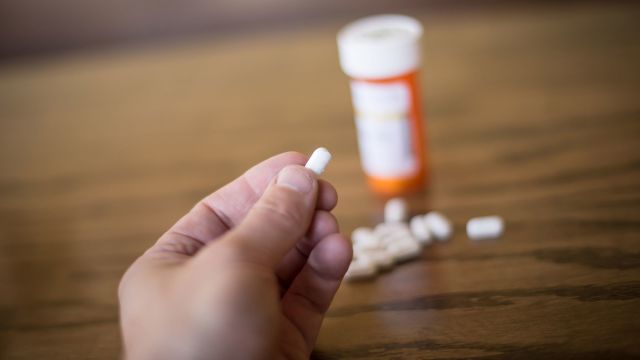Updated on April 6, 2022.
You’ve probably heard about opioids in the news, since abuse and overuse of these powerful pain relievers has contributed to a national crisis of addiction and overdose.
And while opioids have the potential to be misused, they are common medicines that can be helpful for relieving short-term pain, like the kind experienced after major surgery. They can also help with pain management for patients at the end stages of a terminal condition such as cancer. The evidence is not good, however, that opioids relieve long-term chronic pain (such as from arthritis, lower back pain or migraine) any better than other standard drug or non-drug therapies.
Safe opioid use
If you’re prescribed opioids, it’s crucial to take them only in the amount and duration specified by your healthcare provider (HCP) because the potential downsides to inappropriate use of the drugs are severe. They lead to addiction in up to 25 percent of long-term users, according to some estimates, and are implicated in the overdose deaths of several dozen Americans each day.
Here are some key things to keep in mind for safe opioid use.
Ask if you really need them at all
Many experts are concerned that opioids are being prescribed when they’re not medically necessary. A study published in September 2018 in the Annals of Internal Medicine found that nearly 30 percent of the time when doctors prescribed opioids, a diagnosis of pain was not included with the prescribing documentation—and a missing pain diagnosis was even more common in the case of prescription renewals.
Even for patients who do have chronic pain, opioids are usually of limited use. A study published in March 2018 in JAMA found that patients who took opioids for chronic back, knee or hip pain didn’t do any better—and in some cases had worse pain—than those who took non-opioid pain medications.
While some physicians prescribe opioids for migraines, the American Headache Society recommends that they only be used as a last resort or in cases in which first-line treatments aren’t a viable option. The potential downsides to using opioids for headaches are that they can lead to more frequent and severe headaches as well as opioid dependency.
Keep opioids safe from others
If you are prescribed an opioid, it’s important to keep your medication away from anyone in your household who shouldn’t be taking them, especially children. Never leave your pills or containers lying around where others can access them. Instead, keep them stowed in a secure, out-of-the-way medicine cabinet, ideally one with a lock. It’s also a good idea to count your pills after each use to keep track if any go missing.
Anticipate side effects
It’s critical to speak to your HCP about the potential side effects you may experience while on the drugs—such as headaches, fogginess, sleepiness, nausea, vomiting and constipation—so you know what to expect and when to report anything that’s out of the ordinary.
Stick to the shortest and lowest dose opioid possible
Your HCP should prescribe your medication for the shortest course and at the lowest dose she thinks will be effective to treat your pain. The Centers for Disease Control and Prevention (CDC) says that most of the time, you won’t need to take opioids for more than three days and that it’s rare for people to need them for more than seven.
If you take them longer than that, you have a much higher risk of becoming dependent, according to a 2017 study from the CDC. Only 6 percent of patients taking an opioid prescription for a day or more were still using it a year later, but that number jumped to 13.5 percent for patients using an opioid for eight or more days—and to nearly 30 percent for those whose first experience taking a prescription opioid ran for 31 days or longer.
If this is your first opioid prescription and you’re being treated for acute pain, it’s generally recommended that you take immediate-release opioids rather than an extended-release/long-acting (ER/LA) version. ER/LA opioids, which stay in the body longer and are typically stronger, are usually reserved for patients with severe, ongoing pain who have already taken immediate-release opioids for a week or more.
Don’t try to adjust your own dose
If you’re taking an opioid and the medication seems to have worn off—in other words, if you’re still in pain—don’t increase your dose. Instead, call your HCP. Taking more than you’re prescribed can depress your breathing, setting you on the path toward serious life-threatening complications.
Don’t mix opioids with certain meds
Combining opioids with other drugs—such as over-the-counter or prescription sleep medications or anti-anxiety medications—can increase potentially deadly side effects such as depressed breathing. The same is true with alcohol. Always tell your prescribing HCP about all the other medications and supplements you’re taking, so they can help make sure you’re not setting yourself up for any dangerous drug interactions.
Don’t stop cold turkey
If you’ve been prescribed an opioid to deal with acute pain for less than two weeks, you should be able to stop taking the drug when your prescription runs out. But if you’ve been taking one for more than two weeks, you may need to stop gradually. Discuss the process of tapering your prescription with your HCP.
When weaning off the drugs, you may experience withdrawal symptoms—including anxiety, increased pain, trouble sleeping, nausea or rapid heart rate. But most people who do taper off have improved day-to-day function without worse pain. You should be able to stop completely once you’ve gotten down to the lowest possible dose less than once a day.
Remember: Only attempt to alter, reduce or stop taking a drug in consultation with your HCP.
Discard leftover pills immediately
More than 60 percent of Americans prescribed opioids keep the extras around, according to a study published in 2016 in JAMA Internal Medicine. That’s a bad idea for several reasons.
For one, you may decide to take a pill when you don’t really need it for something outside of your original prescription—for example, to relieve the pain of a pulled back muscle. Keeping extra pills around also increases the risk that loved ones around you could become addicted. Forty percent of people who misused opioids got them from friends and family members, according to results of a national survey published in 2017 in the Annals of Internal Medicine.
If you have the remainders of an opioid prescription, don't just toss the pills into the garbage, because they could end up in the wrong hands. You can contact your local police department or trash service to see if they have medicine takeback programs. Some pharmacies will take drugs for disposal, and some prescription plans offer drug disposal bags; call to ask if they are available.
If a takeback opportunity is not immediately available, however, the U.S. Food and Drug Administration (FDA) recommends that you flush most opioids down the toilet right away to dispose of them as soon as they’re no longer needed. Learn more about safe disposal of medications from the FDA and consult the agency’s “flush list.”
Know the signs of an incorrect dose and overdose
Overdoses aren’t always the result of illicit use (in other words, trying to get high). They are sometimes caused by inadvertent mistakes, such as taking too large a dose, taking it too soon after a previous dose or mixing it with another drug or alcohol.
If after taking your prescription, you feel intoxicated, dizzy, especially groggy or sleepy or are having trouble waking up and staying alert, call your HCP, as these are signs that you may have taken the wrong dose of your medication.
And be on the lookout for any of the following signs of an overdose in a loved one who’s taken an opioid:
- Loss of consciousness
- Breathing or heartbeat that slows or stops
- Vomiting or gurgling noises
- Limp body
- Pale, clammy skin and/or blue lips or fingernails
- “Pinpoint” or constricted pupils
In these cases, call 911 immediately for emergency help, and administer naloxone if available.







